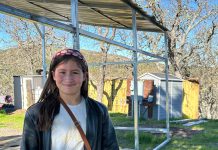Local high schoolers continue to beat the state graduation rate,
according to recent figures from the state Department of
Education.
The county graduated 92.9 percent of students compared to the
state’s 86.9 percent for the 2001-02 school year, the most recent
information available.
Local high schoolers continue to beat the state graduation rate, according to recent figures from the state Department of Education.
The county graduated 92.9 percent of students compared to the state’s 86.9 percent for the 2001-02 school year, the most recent information available.
Anzar High School’s rate was 94.5, San Benito High School’s was 95.7 and San Andreas Continuation High School’s was 82 percent. The rates take into account students who graduated minus those dropped out of school.
A student is considered a dropout when he or she no longer attends school and their transcripts are not sought by another school.
The main reasons students drop out of high school include family issues and getting behind in units.
“It happens around junior year – that’s when they quit seeing the light. There’s no rainbow at the end of the path. They get really frustrated at that point,” said Duane Morgan, interim principal at SBHS.
Some students return to school eventually, even though it may not be their original high school.
“What’s common around the state is that some kids (leave) and we don’t really know where they go to,” Morgan said. “We find that kids finally graduate by age 22 some how and some place.”
Over the last three years of data, SBHS has hovered around a 95 percent graduation rate. San Andreas has steadily increased from 73.2 percent in 1999-00 to 82 percent in 2001-02. Anzar remains in the 90th percentile with a high of 100 percent of students graduating in 2000-01.
Because Anzar has a small student population, a drop of 5 percent indicates one student, Director Charlene McKowen said.
“Dropouts hardly ever happen here,” she said. The student who dropped out in 2001-02 graduated after returning to Anzar for a fifth.
California’s graduation rates are based on the National Center for Educational Statistics definition, which divides the number of graduates at a school by the number of graduates as well as the number of dropouts for each of the four years.
Alpine County, with five graduates, had the highest graduation rate in the state at 100 percent, according to the 2001-02 data. Sacramento earned the lowest percentage with 80.3 percent graduating. San Benito County came in with 92.9 percent.
While officials are always concerned when students drop out of school, they need to beef up the tracking of students, Morgan said.
“We’re (SBHS officials) trying to catch them early. We’re trying to get them into programs where they’ll be successful, like ROP (Regional Occupation Programs) or independent study,” he said.
High school graduation rate data will be combined with other accountability figures to measure whether or not a high school meets its Adequate Yearly Progress, or AYP, target. An improvement of 0.1 percent in the schoolwide graduation rate from the prior year is required for a school to meet its AYP.
Officials at Anzar are afraid of what the 0.1-percent requirement means for the school since it already has a high graduation rate and one or two students can drastically change the numbers. The requirement is unfair to small high schools since the 0.1 percent is equivalent to a only a portion of a student, not a whole student.
For other high schools, the measure is fair, as long as the benchmark stays, Morgan said.
“As long as (state officials) don’t change their mind – the state has a habit of changing things mid-stream,” he said. “The (state’s) rate is pretty accurate (compared to SBHS’s numbers). It gives a pretty accurate picture of where our students are.”
Along with graduation rates, the Department of Education also released data on the number of high school graduates with University of California/California State University required courses. More students across the state and county are taking UC/CSU required courses, necessary for admission to UC’s or CSU’s.
In 2001-02, Anzar graduated 37 students, 71.2 percent, with the courses; SBHS had 205, or 41.8 percent; and San Andreas graduated no students with the requirement. In this area, the county also beat the state’s average – 35.6 percent to 34.7 percent.
Details: www.cde.ca.gov.









